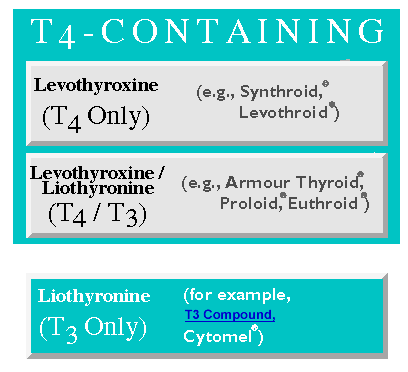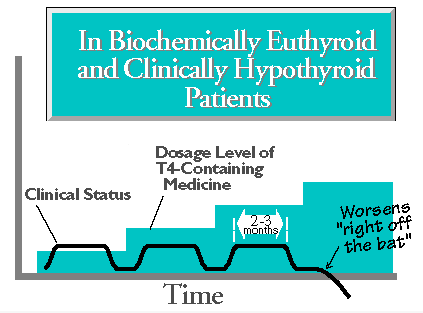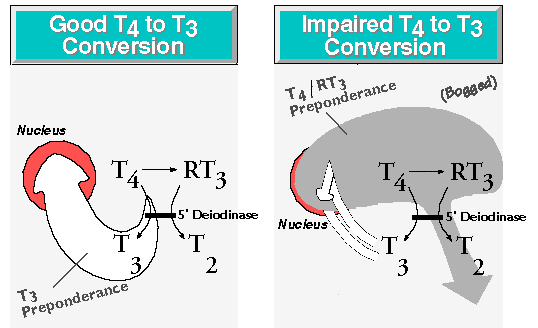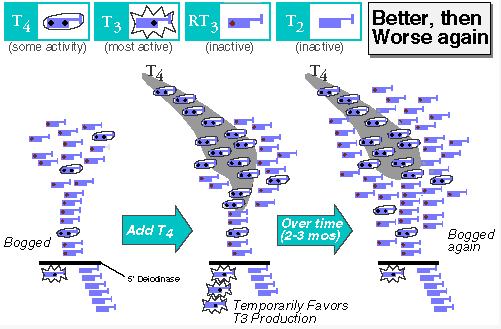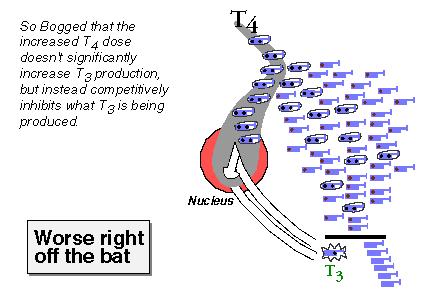In my experience, the “resetting phenomenon” doesn’t really occur with the use of T4-containing medicines (which can actually make Wilson’s Temperature Syndrome worse).
I refer to the phenomenon of the symptoms of Wilson’s Temperature Syndrome remaining improved even after the T3 therapy has been discontinued, as the “resetting phenomenon.”
As mentioned previously, the resetting phenomenon does not really occur with the use of T4-containing medicines (dessicated thyroid, and levothyroxine products).
If patients who are biochemically euthyroid and clinically hypothyroid do improve with the use of a T4-containing preparation, their symptoms almost always return once the treatment is discontinued.
Frequently, however, the symptoms of such patients return even while they are still taking the T4-containing medicine.
And, T4-containing medicines can even make Wilson’s Temperature Syndrome worse.
A CLASSIC STORY: The symptoms of biochimically euthyroid and clinically hypothyroid patients worsen again 2-3 months after improving with each increase of T4-containing medicine, until finally they can worsen “right off the bat” with a given increase.
It is not uncommon for symptoms of biochemically euthyroid and clinically hypothyroid patients to improve with T4-containing medicine, only to worsen again after a time (usually about 2-3 months).
If the dosage of the T4 medicine is then increased, the patient’s symptoms will frequently again improve, only to resurface again after a similar time interval as the first relapse.
If the dosage is increased again, the same cycle may repeat itself, with the patient getting on higher and higher doses of the T4 medicine with the same symptoms returning each time.
Finally, after one such increase the hypothyroid symptoms may worsen “right off the bat,” without the usual initial improvement. This is a relatively bad sign that suggests the patient is being pushed too far in the wrong direction with the wrong medicine.
This is a classic story, and such patients typically require more cycles of T3 therapy in order to return to feeling well on less/no medicine.
Note: Although the blood tests are not very useful in predicting who will, and who will not respond well to T3 therapy, I find it interesting that, by far, the highest RT3/T3 (RIA) ratios that I have seen, are in patients with this kind of story (too far in the wrong direction with the wrong medicine). I calculate this ratio by simply dividing the total RT3 (Radio Immuno Assay) by the total T3 (RIA). I use as a reference point the median of the normal range of RT3 divided by the the median of the normal range of T3, which comes out to about 2 with the units I use. Sometimes untreated patients have RT3/T3 ratios up to about 3 or 4, but the only times I have ever seen ratios of > 6 have been in patients with stories consistent with being pushed too far in the wrong direction with the wrong medicine.
I will offer an explanation for why the symptoms tend to worsen right off the bat but first let us review the function of 5′ deiodinase in the thyroid system.
Impaired T4 to T3 conversion can lead from T3 preponderance to T4/RT3 preponderance. T4/RT3 preponderance can:
1. Perpetuate decreased T3 production and,
2. Competitively inhibit what T3 is produced.
The enzyme 5′-deiodinase converts T4 to T3. It also converts RT3 to T2 (T2 is considered an inactive metabolite). Thus, T4 and RT3 compete for the attention of the same deiodinating enzyme.
It is likely that Wilson’s Temperature Syndrome is perpetuated by this deiodinating enzyme being preoccupied with RT3 at the expense of T4 conversion to T3 (with less T4 being converted to T3 and more therefore being converted to RT3).
This backlog situation leads to what I call T4/RT3 preponderance, as opposed to T3 preponderance.
T4/RT3 preponderance can be problematic in two ways. First, it perpetuates decreased T3 production. Second, it can compete with what T3 is produced, at the level of the nuclear membrane receptor.
Remember, T4 is 4 times less potent, and 3 times longer-acting than T3. So even though it stimulates the thyroid hormone receptor, it does it so much more weakly than T3, that if it occupies the receptor instead of T3, it results in decreased stimulation of the cell.
With T4/RT3 preponderance the thyroid system can get bogged down so that there is insufficient T3 stimulation of the cells.
Note: This all happens outside the blood stream on a cellular level and can’t be measured (p36). It is not necessarily reflected in the blood tests.
Treating Wilson’s Temperature Syndrome with T4-containing medicine may temporarily favor T4 to T3 conversion, stimulation of the cells, and symptom reduction. But over time, the same factors that impaired the conversion of their own T4 to T3 may begin to hinder the conversion of the T4 they’re given by mouth. More of the added T4 can go toward RT3, the system gets bogged down in T4/RT3 preponderance (further inhibiting T3 production and expression), and the symptoms return.
The above typically occurs within 2 – 3 months. If it happens sooner, say in about 3 weeks, that suggests the patient’s system is bogging down rather precipitously. If it happens only after 6 months or a year, it is a more indolent process with outside stress usually playing a more significant role in the impaired T4 to T3 conversion.
Note: If the patient’s symptoms do remain improved on the T4-containing medicine, they will typically return once the T4-containing medicine is discontinued, since the conditions that perpetuated the Wilson’s Temperature Syndrome in the first place (bogging) still exist because of undepleted RT3 levels.
As soon as a person with low temperature and hypothyroid symptoms presents to the office taking more than 1.5 grains of dessicated thyroid, or more than .125 mg of T4, one can almost be sure as to what has happened. This has all the ear-marks of the patient being pushed too far in the wrong direction with the wrong medicine. No one is really started on T4 doses this high, and doctors are usually not persuaded to use higher doses unless there has been at least a partial response on lower doses.
Patients who present in this manner will often relate a history of having done well for a time on the lower dose of T4 (usually about 2 – 3 months), which suggested a successful therapeutic trial and that the treatment was on the right track. But for some “confusing” reason the symptoms returned so it was felt that an increase in the medicine was needed. So the dose was then increased and the cycle repeats. When the dosage is increased, the cycle of initial improvement followed by a return of the symptoms often repeats itself for the same reasons mentioned above.
It can get to the point that with an increase in T4-containing medicine the patient’s symptoms can worsen right off the bat due to the competitive inhibition of T3 at the level of the cell.
It’s good to determine if the person has been pushed so far that the symptoms worsened “right off the bat” with an increase of T4-containing medicine. Patients with such histories are generally among the most difficult to correct, in terms of the number of cycles needed.
Each time the T4 medicine is increased, T3 levels increase; but that is followed with bogging, and increased RT3 levels. It gets to the point that there is so much RT3 present that when the final increase of T4 is given there is no significant increase in T3 stimulation, because of RT3 bogging of the 5′ deiodinase enzyme. Instead, the added T4 just competes at the level of the cell with what T3 is being produced, to actually decrease T3 stimulation of the cell.
This is what I mean by a person being pushed in the wrong direction with the wrong medicine. Using a T4-containing medicine in a Wilson’s Temperature Syndrome patient one can actually worsen the patient’s T4/RT3 preponderance, to levels not found in nature.
I believe this is why the highest RT3/T3 ratios that one ever sees are in cases like these where a patient is being pushed with a T4-containing medicine. It gets to the point where more and more goes to RT3 and less and less goes to T3, generating the lopsided ratios.
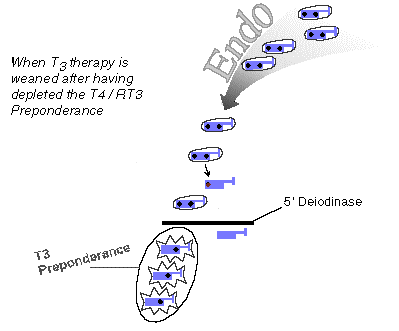
Let’s review. In contrast to T4-containing therapy, T3 therapy favors resetting of the system by depleting RT3 levels for a time.
When a patient is given T3 directly, TSH, T4, and RT3 levels drop due to glandular negative feedback inhibition.
This removes the T4/RT3 preponderance that bogs things down. When the T3 therapy is weaned, and TSH and T4 production resume, the 5′-deiodinase enzyme sees the incoming T4 without much RT3. And since it is no longer preoccupied with RT3, T4 to T3 conversion is favored (a state of T3 preponderance), and the patients are better able to make T3 on their own again.
It appears that the resetting phenomenon is associated with depletion for a time of RT3 levels since it is not really seen with the use of T4-containing medicines. This is the main reason T3 therapy is used in treating Wilson’s Temperature Syndrome instead of T4-containing medicines.
|
Proper T3 therapy is
1. Generally Well Tolerated |
Some people wonder why so many different people and so many different problems might be treated with the same therapy. It is a little like insulin-dependent diabetes. Lots of people have lots of problems because of insufficient insulin. And lots of them do well when they are treated with insulin. One important difference is that patients who do well with T3 can frequently wean off the medicine and continue to do well.
Note: The Physician’s Desk Reference, under the section on Cytomel, states that T3 may be preferred in cases when impairment in the peripheral conversion of T4 to T3 is suspected. It also states that in every case the dosage must be individualized according to patient response and laboratory findings.
The medical literature is a little scanty on expounding upon when one might suspect impaired T4 to T3 conversion, and upon the PDR’s broad recommendation of “according to patient response.” However, there are some important considerations, which is what the Wilson’s Temperature Syndrome book, and the rest of this manual are all about.

